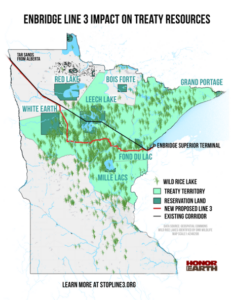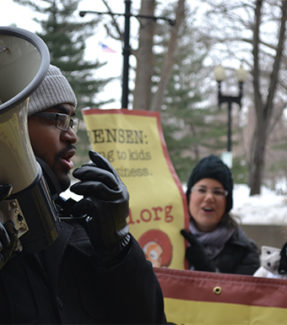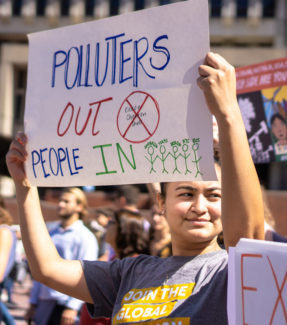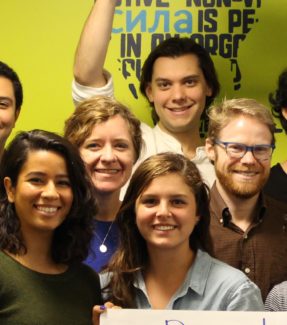This blog post was written by Martha Denton, a Communications and Digital Intern in Corporate Accountability’s intern class of Summer 2021.
On March 3, 1991, the largest inland oil spill in the United States took place in Grand Rapids, Minnesota. Approximately 1.7 million gallons of crude oil flowed from the Line 3 pipeline onto the frozen Prairie River in northern Minnesota, coating the landscape with fossil fuels. The corporation responsible for the pipeline’s failure was Lakehead Pipeline Co., now succeeded by Enbridge Energy. Enbridge has a long history of pipeline incident; nearly 2.8 million gallons of crude oil have been spilled on the corporation’s watch since 2002.
Thirty years have passed since that disastrous spill, and Enbridge is back in northern Minnesota with what it calls a “replacement” of the same pipeline. The project is hardly that. Rather, Enbridge is abandoning the old line and installing a larger pipe in a new corridor with an even dirtier fossil fuel: tar sands. Line 3 cuts through Indigenous treaty territories, threatening to pollute the water in the Mississippi River and destroy the wild rice sacred to the Anishinaabe people. The pipeline would have an impact equivalent to 50 coal-powered power plants—greater than the emissions of the entire state of Minnesota in 2016. In the words of Indigenous author Louise Eldrich: “This is not just another pipeline. It is a tar sands climate bomb.”
In the face of this blatant corporate abuse to people and the planet, there is a powerful grassroots Indigenous-led resistance in northern Minnesota. Since the pipeline is being constructed less than a hundred miles from my home in North Dakota, I felt compelled to offer whatever labor and resources I could. Over the past few months, I spent time at three camps fighting to stop Line 3.
In writing this, I hope to give a brief snapshot of what I learned there. I don’t intend to speak for the movement, which is led by a powerful group of Indigenous women and two-spirit people. If you have not already, I highly recommend reading words from organizers on the frontlines of this movement—Tara Houska, Winona LaDuke, Tania Aubid, Taysha Martineau, Sasha Beaulieu, and many others—and supporting them however you can.
The movement to stop Line 3
The Line 3 pipeline begins in the Alberta tar sands and cuts diagonally across northern Minnesota to Superior, Wisconsin. Along the path of the pipeline, there are a number of resistance camps. Some camps focus on direct action to delay construction, others on initiating symbolic arrests to bring awareness, others on art, and others on prayer. Their tactics vary, but their goal is the same: to stop Line 3.
I was surprised by how much work there is to do on the frontlines beyond participating in actions and generating media coverage. Camp maintenance—cooking food, washing dishes, gardening, fixing yurts, carrying water, chopping wood, clearing paths, and other labor—is necessary to support those taking action.
Water protectors on the frontlines experience intense surveillance and harassment by local law enforcement who are funded by Enbridge itself. The escrow account that Enbridge created for pipeline policing essentially puts public police forces in the pocket of a multinational corporation. These “corporate counterinsurgency” efforts, similar to those seen at Standing Rock, mean that organizers are constantly monitored and arrested on bogus charges. Because of these conditions, life on the frontlines is often dangerous and unpredictable. Not to mention the grief that comes along with watching forests cut clear, rivers drained, and the earth torn up—all in the name of maximizing shareholder value.
Yet despite these challenges, people from all different backgrounds have shown up to resist this pipeline and be in community with one another. White supremacist norms of hierarchy and scarcity are rejected in favor of solidarity and humility. There’s a feeling that a new world is being built through the resistance to the current one.
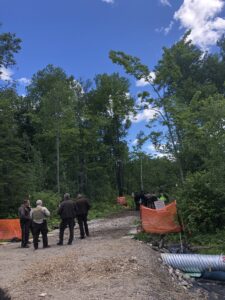
Four police officers stand huddled at one of the entrances to a Line 3 resistance camp in Minnesota. Photo credit: Martha Denton.
While in Minnesota, I also spent some time at the occupation in response to the murder of Winston Smith. There’s a strong feeling of solidarity between organizing efforts against police brutality and pipelines. Many Black organizers from Minneapolis had traveled up to the frontlines to protest Line 3. Similarly, many Indigenous organizers from the Line 3 movement showed up for the occupation. The folks I spoke with expressed how deeply these movements are rooted in the injustice of capitalist exploitation and violence.
How you can take action
The momentum against this pipeline is growing. In early June, over 2,000 people came to northern Minnesota for the Treaty People Gathering and about 200 people were arrested.
Despite national outrage over this project, the Biden Administration has refused to revoke its permits. Pipes are still being installed, ecosystems disrupted, treaties violated, the climate jeopardized, and food and water systems threatened.
But we are not powerless in the face of abusive corporations. Line 3 is being challenged through legal action, political pressure, and educational efforts. Here are some ways you can take action and support the movement to stop Line 3:
- Travel to the frontlines to support Indigenous leaders and take part in actions! First, register for an action orientation call and familiarize yourself with the logistics and norms of frontlines solidarity work.
- Take digital action by sending an email to the CEOs of 18 banks to defund the pipeline and signing the petition to President Biden asking his administration to review construction permits.
- Call your Representatives asking them to sign on to the letter from Representatives Tlaib and Omar urging President Biden to Stop Line 3.
- To financially support water protectors, donate to the Line 3 Legal Defense Fund, Honor the Earth, or directly to the frontlines.
- Organize to divest your community from the banks funding Enbridge and fueling the climate crisis.
- Spread awareness in your neighborhood by requesting a lawn sign.
- To continue educating yourself, watch the documentary “LN3: 7 Teachings of the Anishinaabe Resistance” or read the latest book from Winona LaDuke, “To Be a Water Protector.”
- Talk to your friends and family about the movement to stop Line 3 and encourage them to take action against corporations abusing people and the planet!
